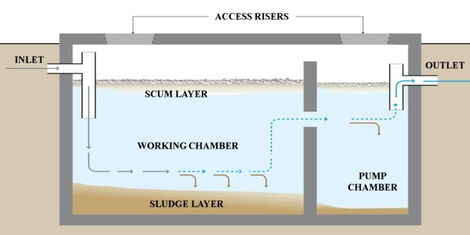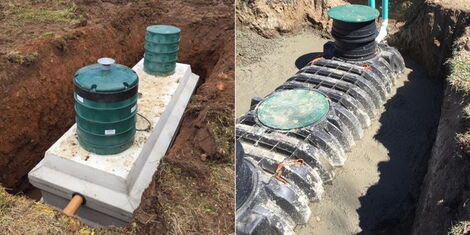Most homes in urban and rural areas work around having efficient septic tanks in managing household waste.
This is very important in areas where there are no public sewer systems and therefore homeowners install septic tanks to dispose of wastewater.
As an alternative to sewer systems, these large tanks help to filter solid and liquid waste.
Usually, septic tanks are placed underground in the yard area adjacent to the home. The drains from the sinks, showers, and toilets all flow into this tank where they are then filtered.

Heavier matter sinks to the bottom of the tank and the filtered water and liquid then exit the septic tank where it drains into a designated area.
It’s an efficient way to care for the sewage from your home without having to plumb your home for sewage lines.
Septic tanks come in different designs and when choosing the best design for your home, it is recommended to seek an expert opinion on the type and size of the tank, materials to use, mode of installation, and maintenance system.
They could be made of different materials such as steel, concrete, plastic, or fibre.
There are however a few ways you can determine which tank will best suit the needs of your family.
1. Know the Size Requirements
The size of the system is dependent on the number of people expected to use the system.
Typically, the breakdown of wastewater in the septic tank is slow so it has to be dug deeper than say a biodigester.
An undersized septic tank can cause problems like foul odours, overflows, and blockages.
On the other hand, oversized septic tanks won’t have enough water to work correctly.
2. Understand the Type of Wastewater
The type of wastewater influences the type of septic tank system.
Homes will mostly release blackwater and greywater sewage.
Blackwater is wastewater from toilets and has urine and faeces.
Your septic tank must have a filtration system to handle blackwater.
Grey water is wastewater from all domestic areas except toilets, such as laundry and dishwashing.
The wastewater may contain pathogens like viruses, bacteria, and parasites.
3. Select the Appropriate Design
While the general ideas of septic tanks are the same, there are a few designs to choose from.
If your tank is going to be installed in an area with gravel or coarse soil, a pressure-type septic system is best.
However, the ideal septic design will depend on one’s home’s installation and functionality requirements.
The main types of septic tank systems include:
- Decentralized wastewater septic system design
- Open-bottom chambers and fabric-wrapped pipe septic system
- Intermittent sand filter system
- Recirculating sand filter system
- Evaporation septic design
- Mound septic design
4. Choose a Durable Material
A septic tank’s material affects its effectiveness and durability.
The most common types of septic tank materials are coated steel, fibreglass, and concrete.
One can also use polyethene to construct a septic tank.
Concrete tanks are heavy and require cranes during installation.
Additionally, concrete tanks are ideal for waterlogged soils because the heavy tanks won’t float easily.
You can also reinforce concrete tanks with other materials to increase depth.
5. Pick the Correct Pump
A pumping system will provide power to remove the sewage from the septic tank.
No matter the size or design, each septic system is designed with one of two types of pumps.
A turbine pump is considered the superior of the two because they are more reliable and tend to last much longer.
However, due to their increased reliability, they’re often more expensive. A centrifugal pump may not last as long, but it’s much less expensive.
Both turbine and centrifugal pumps are available in different sizes, making it simple to select the one best for your tank.
Conclusively, plastic septic tanks are less expensive than concrete tanks in terms of cost.
The condition of your soil will also play a significant influence in determining the type of septic tank you choose.

Source: kENYANS.CO.KE




